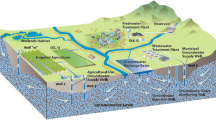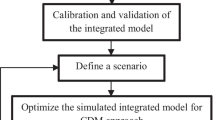Abstract
Water resources are one of the important supply factors for urban survival and development. The water demand of a city and the amount of water supplied by the natural environment affect the overall development of the city. In this study, remote sensing image interpretation is used to classify land use and predict ecological water demands. An optimal allocation model of multisource and multiuser water resources has been established. The allocation of water resources in 2020 and 2030 was also forecasted.
Similar content being viewed by others
References
Lee TR (2000) Urban water management for better urban life in Latin America. Urban Water 2(1):71–78
Gillies RR, Box JB, Symanzik J, Rodemaker EJ (2003) Effects of urbanization on the aquatic fauna of the Line Creek watershed, Atlanta—a satellite perspective. Remote Sens Environ 86(3):411–422
Martınez F, Casermeiro M, Morales D, Cuevas G, Walter I (2003) Effects on run-off water quantity and quality of urban organic wastes applied in a degraded semi-arid ecosystem. Sci Total Environ 305(1–3):13–21
Wang W, Tang X, Huang S, Zhang S, Lin C, Liu D, Che H, Yang Q, Scholz M (2010) Ecological restoration of polluted plain rivers within the Haihe River basin in China. Water Air Soil Pollut 211(1–4):341–357
Li LJ, Zheng HX (2000) Environmental and ecological water consumption of river systems in Haihe-Luanhe basins. Acta Geogr Sin 55(4):500–505
Cui B, Yang Z (2002) Eco-environmental water requirement for wetlands in Huang-Huai-Hai area, China. Prog Nat Sci 12(11):841–848
Arroyo P, Blanco I, Cortijo R, de Luis Calabuig E, Ansola G (2013) Twelve-year performance of a constructed wetland for municipal wastewater treatment: water quality improvement, metal distribution in wastewater, sediments, and vegetation. Water Air Soil Pollut 224(11):1762
Tian Y, Yang Z, Liu J et al (2003) Preliminary study on urban eco-environmental water requirements. Acta Sci Circumst 23(1):104–110 (in Chinese)
Rijsberman MA, Van De Ven FH (2000) Different approaches to assessment of design and management of sustainable urban water systems. Environ Impact Assess Rev 20(3):333–345
Delpla I, Baurès E, Jung AV, Thomas O (2011) Impacts of rainfall events on runoff water quality in an agricultural environment in temperate areas. Sci Total Environ 409(9):1683–1688
Mingzhe H, Luhe W, Xu Y (2016) Study on the division of ecological red line in Harbin section of Songhua River basin. Econ New Urban 7:160–178
Yuan X, Sarma V (2011) Automatic urban water-body detection and segmentation from sparse ALSM data via spatially constrained model-driven clustering. IEEE Geosci Remote Sens Lett 8(1):73–77
Wang L, Fang F, Yuan X, Luo Z, Liu Y, Wan B, Zhao Y (2017) Urban function zoning using geotagged photos and openstreetmap. In: IEEE International Geoscience and Remote Sensing Symposium, pp 815–818
He Y, Li W, Li G, Min Q, Zhao H (2004) Ecological water requirement of forests in Loess Plateau. Environ Sci 25(3):35–39
Wang GG, Gandomi AH, Alavi AH, Gong D (2017) A comprehensive review of krill herd algorithm: variants, hybrids and applications. Artif Intell Rev. https://doi.org/10.1007/s10462-017-9559-1
Acknowledgements
This work was supported by the National Science and Technology Major Project of China (2013ZX07201007-006) and the Doctor Innovative Research Project of Harbin Normal University (HSDBSCX2014-01).
Author information
Authors and Affiliations
Corresponding author
Rights and permissions
About this article
Cite this article
Qi, S., Wan, L. & Fu, B. Multisource and multiuser water resources allocation based on genetic algorithm. J Supercomput 76, 3222–3230 (2020). https://doi.org/10.1007/s11227-018-2563-7
Published:
Issue Date:
DOI: https://doi.org/10.1007/s11227-018-2563-7




